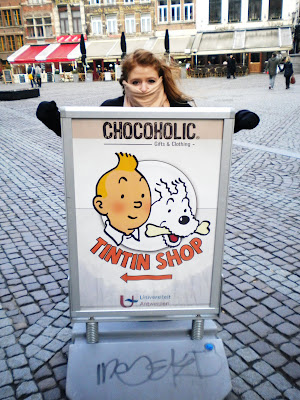This church was begun in the 14th century and finished in 1518. The church has four works by Rubens; "The Descent from the Cross", "The Elevation of the Cross", "The Resurrection of Christ" and "The Assumption"
The legend behind this statue involves a mythical giant called Antigoon who lived near the Scheldt River. He exacted a toll from those crossing the river, and for those who refused, he severed one of their hands and threw it into the Scheldt River. Eventually, the giant was slain by a young hero named Brabo, who cut off the giant's own hand and flung it into the river. Hence the name Antwerpen, from Dutch hand werpen—akin to Old English hand and wearpan (to throw), that has changed to today's warp. Interesting, huh? BELGIAN CHOCOLATE
BELGIAN CHOCOLATEWhen it comes to chocolates, there are the everyday candy bars we consume every day, the more exotic Godiva or Ghirardelli-style chocolates found in coffee houses and specialty stores, and then there is Belgian chocolate. Belgian chocolate is considered to be the gourmet standard by which all other chocolate confections are measured. Molto delicioso!
 The castle made it possible to control the access to the Schelde, the river that flows through Antwerp. It was also used as a prison between 1303 and 1827. Captivity itself was not punishment - the prison was where you awaited your sentence. Very popular punishment available was; chopping of hands, heads and/or burning and quartering (ew!). Supposedly the prison’s regime was not a very honest one.
The castle made it possible to control the access to the Schelde, the river that flows through Antwerp. It was also used as a prison between 1303 and 1827. Captivity itself was not punishment - the prison was where you awaited your sentence. Very popular punishment available was; chopping of hands, heads and/or burning and quartering (ew!). Supposedly the prison’s regime was not a very honest one.
 INTERIOR OF ST. JAMES
INTERIOR OF ST. JAMESSt. James contains the tomb of Peter Paul Rubens.
Sir Peter Paul Rubens was a prolific seventeenth-century Flemish Baroque painter, and a proponent of an extravagant Baroque style that emphasized movement, color, and sensuality. He is well-known for his Counter-Reformation altarpieces, portraits, landscapes, and history paintings of mythological and allegorical subjects.
Central Station is a railway station designed by Louis Delacenserie that was completed in 1905. It has two monumental neo-baroque facades, a large metal and glass dome (60m/197 ft) and a gilt and marble interior. Ciao Ciao!!









No comments:
Post a Comment